Analysis of Influence Characteristics of Site Conditions on Seismic Response of Utility Tunnel
Abstract
:1. Introduction
2. Numerical Simulation
3. Results and Discussion
3.1. Analysis of Acceleration Response
3.2. Analysis of Displacement Response
3.3. Analysis of Stress Response
3.4. Limitations and Future Work
4. Conclusions
- (1)
- In identical site conditions, the clay experiences higher acceleration of the soil compared to the sand. As the utility tunnel structure is buried deeper, the peak acceleration of the soil on the roof initially decreases before rising again. The lowest acceleration peak is observed at a depth of 7.5 m, followed by a gradual increase at a depth of 10 m. Clay soil exhibits a higher acceleration amplification factor compared to sand when subjected to the same ground motion intensity.
- (2)
- Under the same site conditions, the utility tunnel structure experiences a higher peak displacement in clay than in sand. As the structure of the utility tunnel is buried deeper, the peak displacement of the utility tunnel decreases gradually, while the rate of decline in peak displacement of the utility tunnel structure increases. The rate of decline in the clay area is greater than that in the sand. The lateral displacement difference of the utility tunnel increases first and then decreases with the increase in the burial depth of the structure, and the maximum is reached at a burial depth of 7.5 m. The seismic response of buried structures with a depth of 7.5 m should receive greater attention.
- (3)
- The stress distribution in the utility tunnel structure is altered. The maximum von Mises stress occurs at the interface between two soils. The stress in the middle partition of the utility tunnel rises gradually as the depth of burial increases. The stress distribution of the utility tunnel structure changes. As burial depth increases, the deformation of the utility tunnel structure in the clay gradually changes from transverse bending deformation to vertical bending deformation due to the overburden load. The structure of the utility tunnel in the sand continues to experience transverse bending deformation as its depth increases due to the non-homogeneous site.
Author Contributions
Funding
Data Availability Statement
Conflicts of Interest
References
- Luo, Y.; Alaghbandrad, A.; Genger, T.; Hammad, A. History and recent development of multi-purpose utility tunnels. Tunn. Undergr. Space Technol. 2020, 103, 103511. [Google Scholar] [CrossRef]
- Golany, G.S.; Ojima, T. Geo-Space Urban Design; John Wiley & Sons: Hoboken, NJ, USA, 1996. [Google Scholar]
- Hashash, Y.M.; Hook, J.J.; Schmidt, B.; John, I.; Yao, C. Seismic Design and Analysis of Underground Structures. Tunn. Undergr. Space Technol. 2001, 16, 247–293. [Google Scholar] [CrossRef]
- Shamsabadi, A.; Sedarat, H.; Kozak, A. Seismic Soil-Tunnel-Structure Interaction Analysis and Retrofit of the Posey-Webster Street Tunnels. In Proceedings of the 2nd US-JAPAN Soil-Structure-Interaction Workshop, Tsukuba, Japan, 6–8 March 2001; pp. 1–21. [Google Scholar]
- Debiasi, E.; Gajo, A.; Zonta, D. On the seismic response of shallow-buried rectangular structures. Tunn. Undergr. Space Technol. 2013, 38, 99–113. [Google Scholar] [CrossRef]
- Guo, E.; Wang, P.; Liu, S.; Wang, X. Seismic response analysis of typical utility tunnel system. Earthq. Eng. Eng. Dyn. 2018, 38, 124–134. [Google Scholar]
- Konstandakopoulou, F.; Beskou, N.; Hatzigeorgiou, G. Three-dimensional nonlinear response of utility tunnels under single and multiple earthquakes. Soil Dyn. Earthq. Eng. 2021, 143, 106607. [Google Scholar] [CrossRef]
- Tsinidis, G. Response characteristics of rectangular tunnels in soft soil subjected to transversal ground shaking. Tunn. Undergr. Space Technol. 2017, 62, 1–22. [Google Scholar] [CrossRef]
- Baziar, M.H.; Moghadam, M.R.; Kim, D.-S.; Choo, Y.W. Effect of underground tunnel on the ground surface acceleration. Tunn. Undergr. Space Technol. 2014, 44, 10–22. [Google Scholar] [CrossRef]
- Tang, A.; Li, Z.; Feng, R.; Zhou, X. Model Experiment and Analysis on Seismic Response of Utility Tunnel Systems Using a Shaking Table. J. Harbin Inst. Technol. 2009, 41, 1–5. [Google Scholar]
- Chen, J.; Shi, X.; Li, J. Shaking Table Test of Utility Tunnel under Non-Uniform Earthquake Wave Excitation. Soil Dyn. Earthq. Eng. 2010, 30, 1400–1416. [Google Scholar] [CrossRef]
- Chen, J.; Jiang, L.; Li, J.; Shi, X. Numerical Simulation of Shaking Table Test on Utility Tunnel under Non-Uniform Earthquake Excitation. Tunn. Undergr. Space Technol. 2012, 30, 205–216. [Google Scholar] [CrossRef]
- Ding, X.; Feng, L.; Wang, C.; Chen, Z.; Han, L. Shaking table tests of the seismic response of a utility tunnel with a joint connection. Soil Dyn. Earthq. Eng. 2020, 133, 106133. [Google Scholar] [CrossRef]
- Yue, F.; Liu, B.; Zhu, B.; Jiang, X.; Chen, S.; Jaisee, S.; Chen, L.; Lv, B. Shaking table investigations on seismic performance of prefabricated corrugated steel utility tunnels. Tunn. Undergr. Space Technol. 2020, 105, 103579. [Google Scholar] [CrossRef]
- Jin, Y.; Guo, E.; Wu, H.; Yan, P. Dynamic-response analysis of the branch system of a utility tunnel subjected to near-fault and far-field ground motions in different input mechanisms. CMES Comput. Model. Eng. Sci. 2022, 130, 167–186. [Google Scholar] [CrossRef]
- Wu, X.; Nie, C.; Li, D.; Qiu, F.; Tang, Y. Structural Response of a Prefabricated Utility Tunnel Subject to a Reverse Fault. Buildings 2022, 12, 1086. [Google Scholar] [CrossRef]
- Wang, Z.; Tao, L.; Shi, C.; AN, S. Study on the mechanical behavior of utility tunnel structure considering flexible joints under reverse fault dislocation. J. Railw. Sci. Eng. 2023, 20, 2256–2267. [Google Scholar]
- Wang, Z.; Tao, L.; Shi, C.; An, S.; Liu, J. Response and failure mechanism of utility tunnel with flexible joints under reverse fault: An experimental, numerical, and analytical investigation. Earthq. Spectra 2023, 39, 335–361. [Google Scholar] [CrossRef]
- Yue, F.; Liu, B.; Zhu, B.; Jiang, X.; Chen, L.; Liao, K. Shaking table test and numerical simulation on seismic performance of prefabricated corrugated steel utility tunnels on liquefiable ground. Soil Dyn. Earthq. Eng. 2021, 141, 106527. [Google Scholar] [CrossRef]
- Yue, F.; Liu, B.; Liao, K.; Zhu, B.; Jiang, X. Shaking Table Test Study on Prefabricated Corrugated Steel Utility Tunnels on Non-liquefiable and Liquefiable Ground. Prog. Steel Build. Struct. 2022, 24, 105–110. [Google Scholar]
- Yao, A.; Tian, T.; Gong, Y.; Li, H. Shaking Table Tests of Seismic Response of Multi-Segment Utility Tunnels in a Layered Liquefiable Site. Sustainability 2023, 15, 6030. [Google Scholar] [CrossRef]
- Pan, Q.; Dias, D. Face stability analysis for a shield-driven tunnel in anisotropic and nonhomogeneous soils by the kinematical approach. Int. J. Geomech. 2016, 16, 04015076. [Google Scholar] [CrossRef]
- Du, P. Seismic Response of Utility Tunnel in Inhomogeneous Field. Master’s Thesis, Harbin Institute of Technology, Harbin, China, 2017. [Google Scholar]
- Zhang, J.; He, C.; Geng, P.; HE, Y.; WANG, W.; MENG, L. Shaking table tests on longitudinal seismic response of shield tunnel through soft-hard stratum junction. Chin. J. Rock Mech. Eng. 2017, 36, 68–77. [Google Scholar]
- Darli, C.M.; Aiping, T.; Delong, H.; Jiqiang, Z. Large scale shaking table model test and analysis on seismic response of utility tunnel in non-homogeneous soil. Earthq. Eng. Eng. Vib. 2021, 20, 505–515. [Google Scholar] [CrossRef]
- Cilingir, U.; Madabhushi, S.G. Effect of depth on the seismic response of square tunnels. Soils Found. 2011, 51, 449–457. [Google Scholar] [CrossRef]
- Ma, C.; Lu, D.; Du, X.; Qi, C. Effect of buried depth on seismic response of rectangular underground structures considering the influence of ground loss. Soil Dyn. Earthq. Eng. 2018, 106, 278–297. [Google Scholar] [CrossRef]
- Xu, Z.; Zhuang, H.; Xia, Z.; Yang, J.; Bu, X. Study on the effect of burial depth on seismic response and seismic intensity measure of underground structures. Soil Dyn. Earthq. Eng. 2023, 166, 107782. [Google Scholar] [CrossRef]
- GB 50909-2014; Code for Seismic Design of Urban Rail Transit Structures. State Standard of the People’s Republic of China: Shanghai, China, 2014; p. 185.
- Huang, D.; Zong, Z.; Tang, A.; Huang, Z.; Liu, Q. Dynamic response and vibration isolation of pipes inside a utility tunnel passing through nonhomogeneous soil under seismic action. Soil Dyn. Earthq. Eng. 2022, 163, 107522. [Google Scholar] [CrossRef]
- Luo, J. Research on Dynamic Characteristics of Haikou Red Soil. Master’s Thesis, Hainan University, Haikou, China, 2014. [Google Scholar]
- Xue, X. Deformation Characteristics of Foundation Pit in Sandy Soil. Master’s Thesis, Hainan University, Haikou, China, 2014. [Google Scholar]
- GB 50010-2010; Code for Design of Concrete Structures. China Architecture & Building Press: Shanghai, China, 2010.
- Wang, Z. Application of ABAQUS to Civil Engineering; Zhejiang University Press: Hangzhou, China, 2006. [Google Scholar]
- DU, X.; ZHAO, M.; Wang, J. A Stress Artificial Boundary in Fea for Near-Fieldwave Problemi. Chin. J. Theor. Appl. Mech. 2006, 38, 49–56. [Google Scholar]
- GB 18306-2015; Seismic Ground Motion Parameters Zonation Map of China. Standards Press of China: Beijing, China, 2015.
- Jin, Y. Seismic Response Analysis of the Special Segment of an Urban Underground Utility Tunnel. Master’s Thesis, Institute of Engineering Mechanics, China Earthquake Administration, Harbin, China, 2022. [Google Scholar]
- Huang, J. Study on Nonlinear Seismic Response of Rock Tunnels. Ph.D. Thesis, Beijing University of Technology, Beijing, China, 2015. [Google Scholar]
- Wang, G.; Yuan, M.; Miao, Y. Review of seismic response of structure-soil-structure interaction system. Chin. J. Geotech. Eng. 2018, 40, 837–847. [Google Scholar]
- Ceravolo, R.; Civera, M.; Lenticchia, E.; Miraglia, G.; Surace, C. Detection and localization of multiple damages through entropy in information theory. Appl. Sci. 2021, 11, 5773. [Google Scholar] [CrossRef]
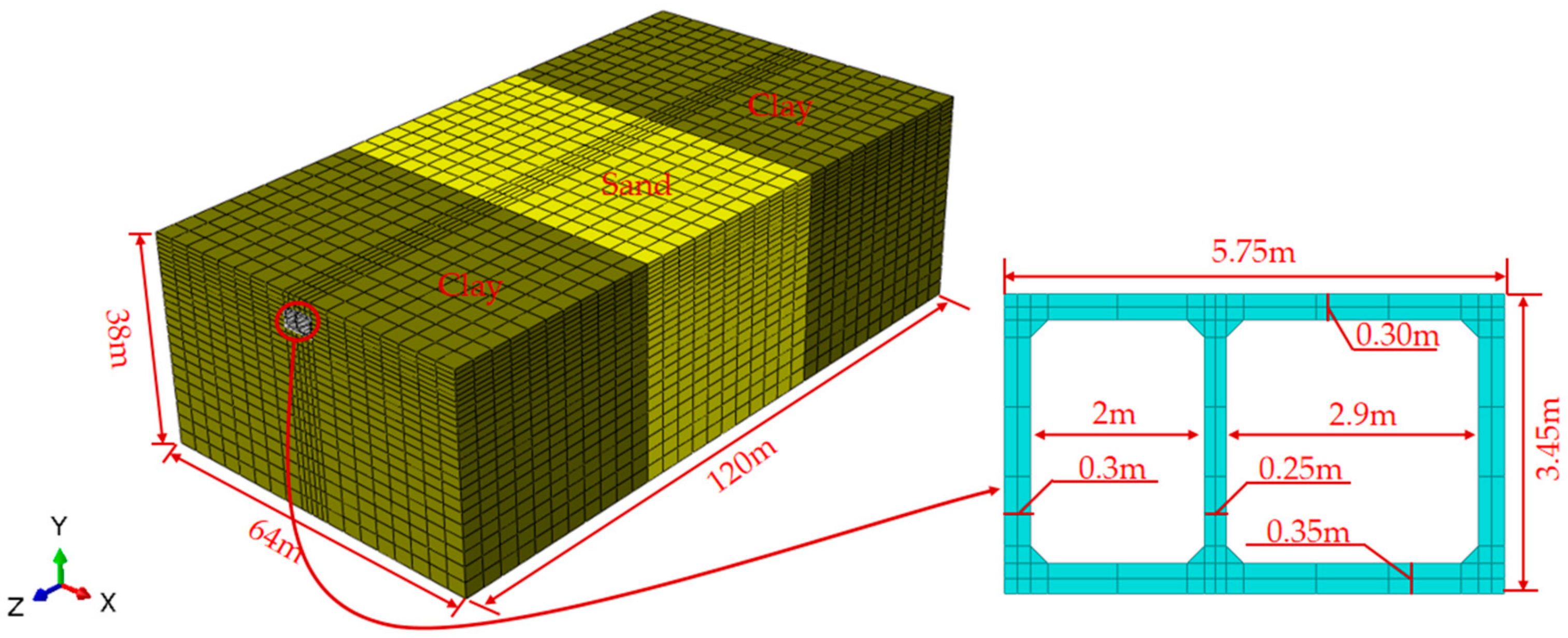
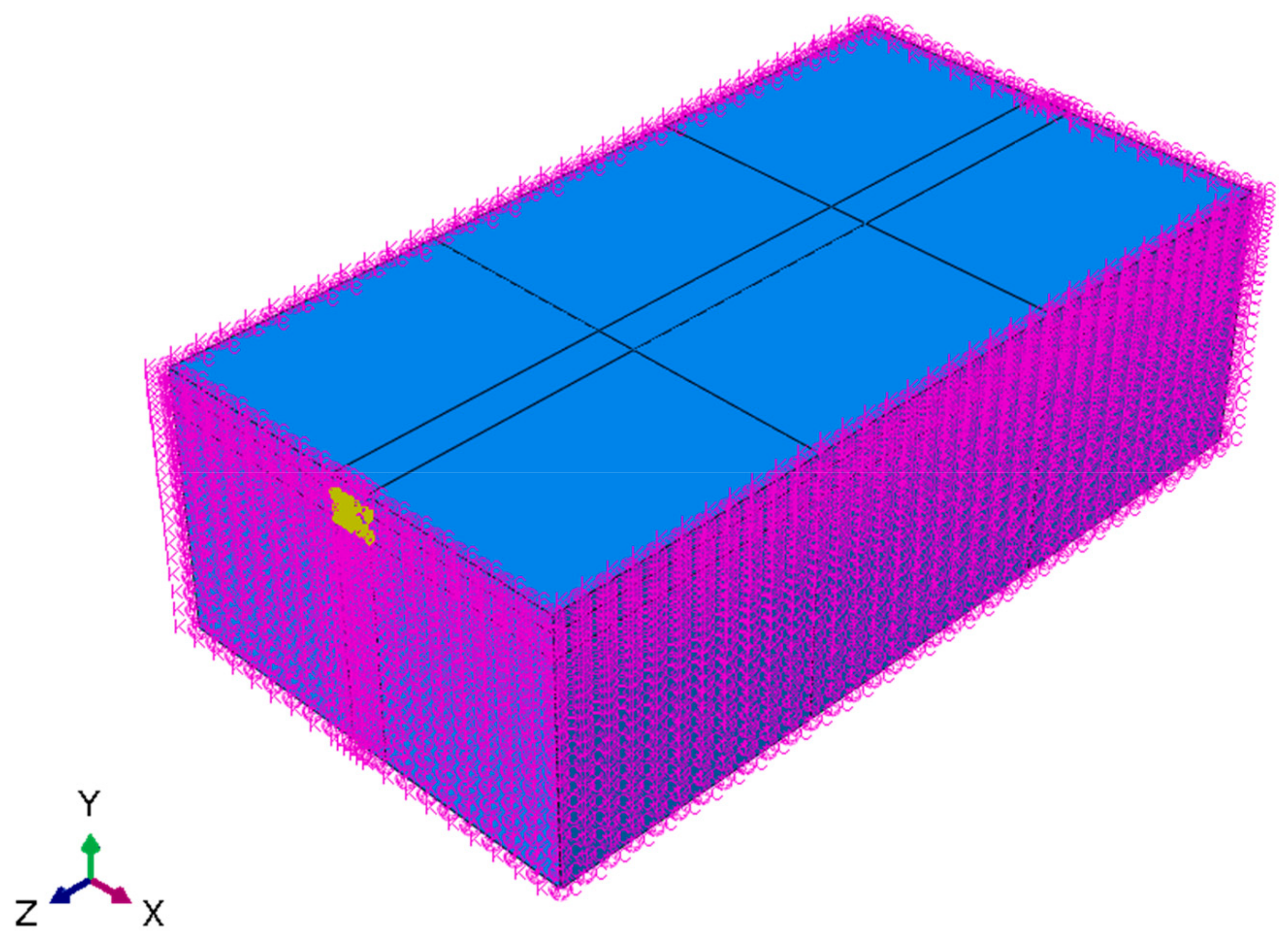
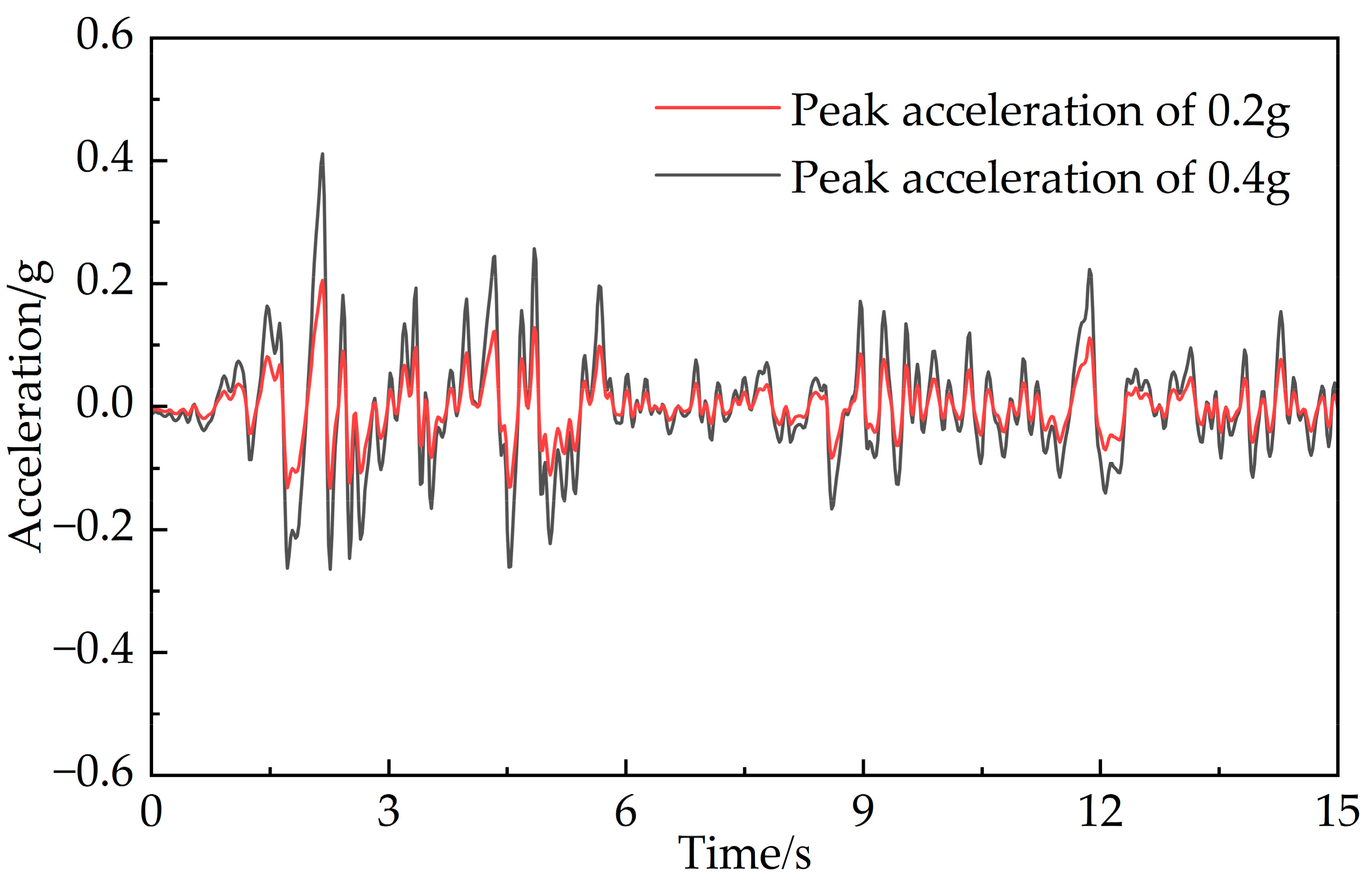
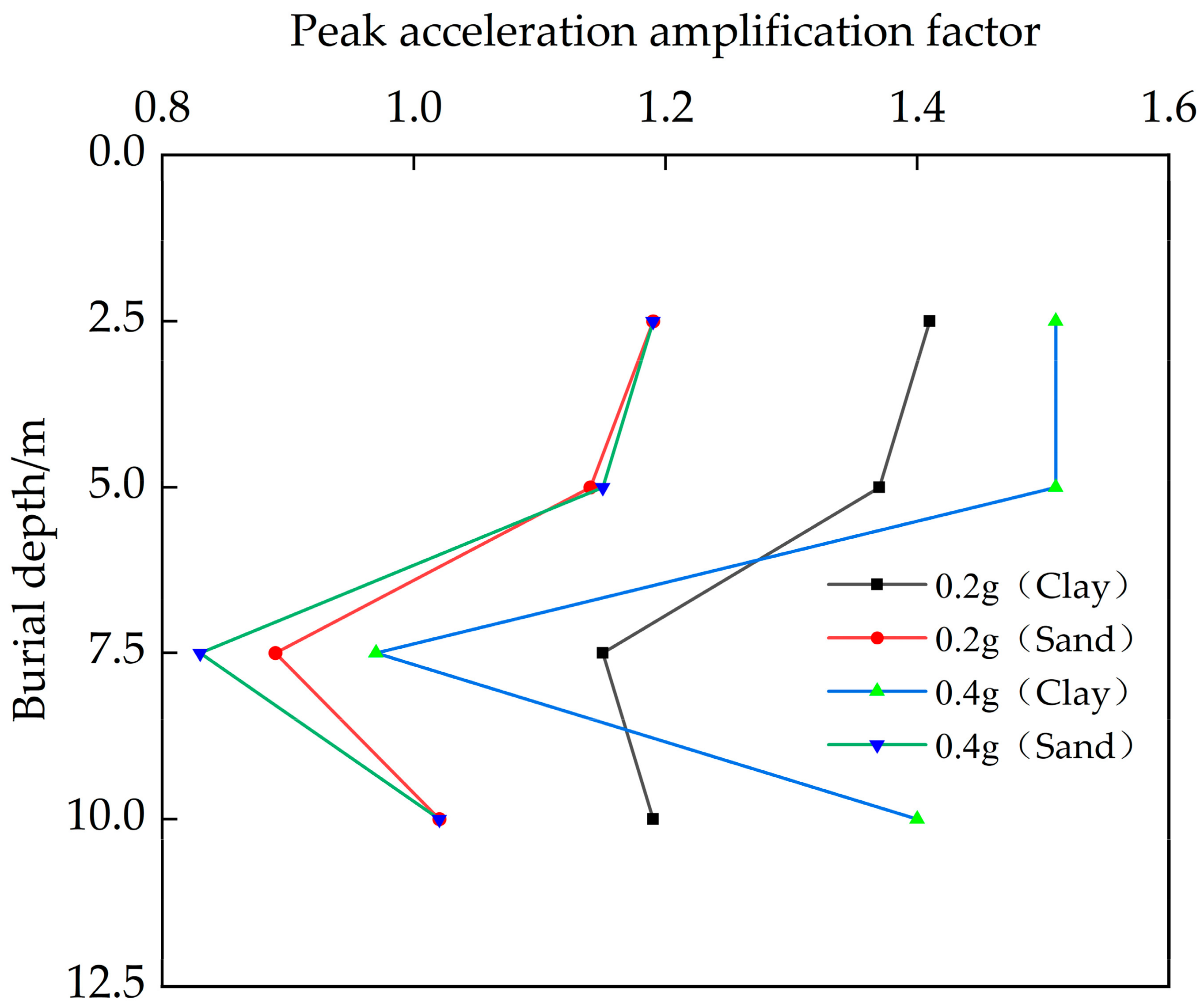

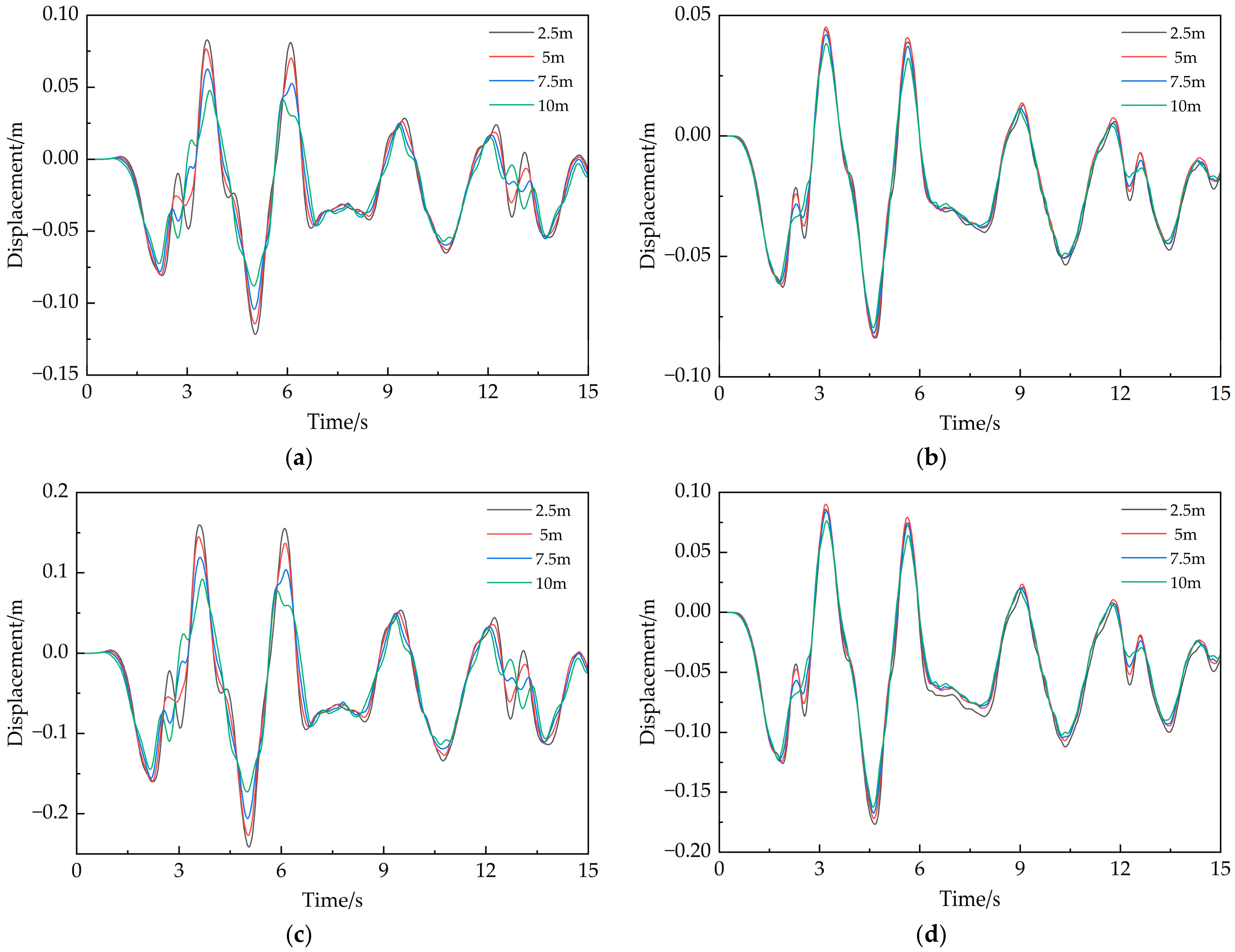

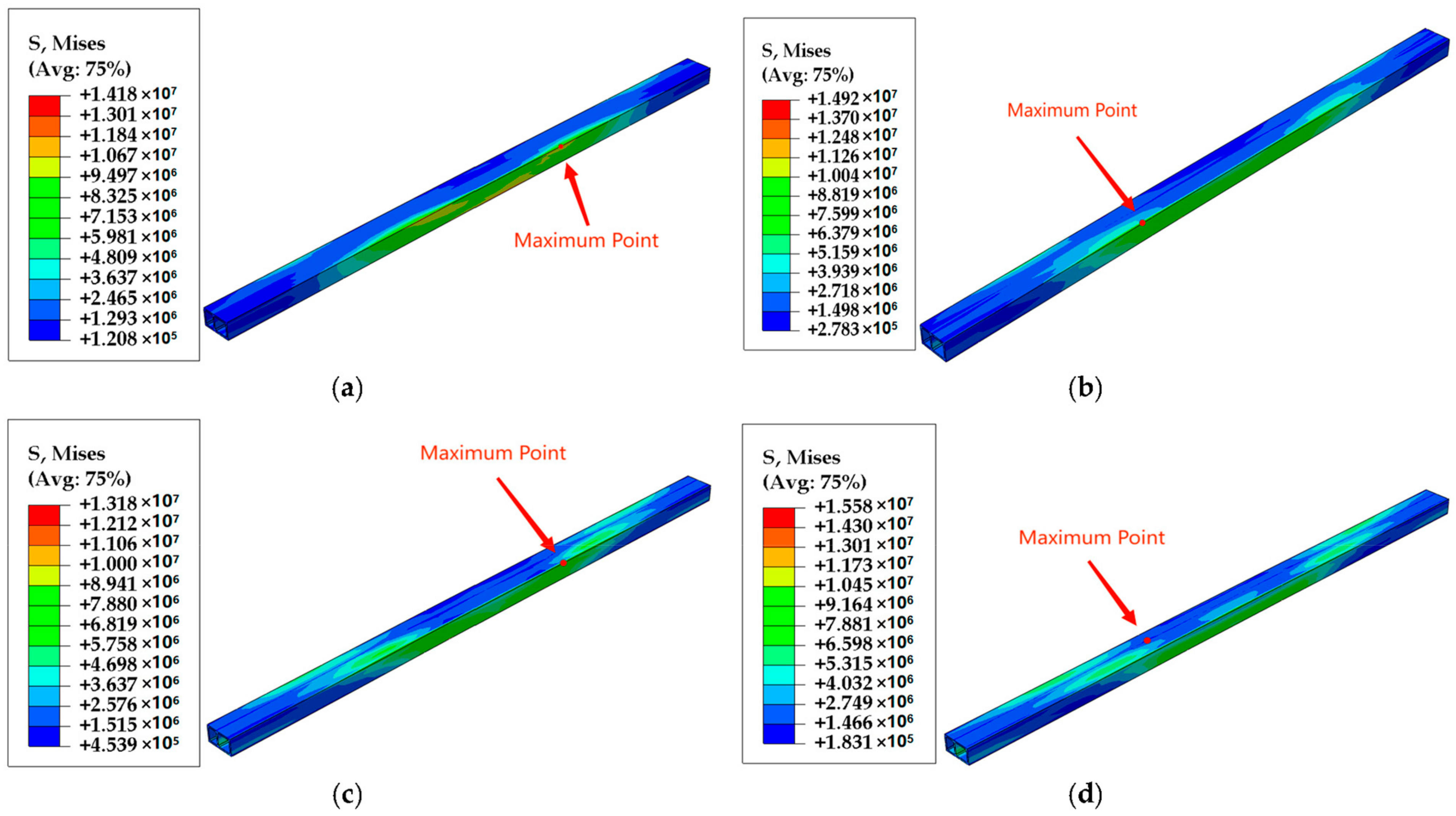


| Soil Type | Density (kg/m3) | Elastic Modulus (MPa) | Poisson’s Ratio | Internal Friction Angle (°) | Cohesion (kPa) | Dilation Angle (°) |
|---|---|---|---|---|---|---|
| Clay | 1850 | 8 | 0.3 | 15 | 35 | 10 |
| Sand | 1900 | 30 | 0.2 | 30 | 10 | 16 |
| Concrete | Steel Bar | |
|---|---|---|
| Density (kg/m3) | 2400 | 7800 |
| Elastic modulus (GPa) Poisson’s ratio | 31.5 | 206 |
| 0.2 | 0.3 | |
| Yield stress (MPa) | - | 400 |
| Dilation angle (°) | 30 | - |
| Eccentricity | 0.1 | - |
| Stress ratio | 1.16 | - |
| K | 0.0667 | - |
| Viscosity parameter | 0.005 | - |
| Stress (MPa) | Inelastic Strain | Damage Factor | Stress (MPa) | Cracking Strain | Damage Factor |
|---|---|---|---|---|---|
| 14.07 | 0 | 0 | 1.76 | 0 | 0 |
| 17.61 | 0.064 | 0.027 | 2.09 | 0.007 | 0.021 |
| 19.97 | 0.141 | 0.069 | 2.09 | 0.047 | 0.167 |
| 22.32 | 0.295 | 0.139 | 1.87 | 0.081 | 0.284 |
| 23.40 | 0.557 | 0.232 | 1.76 | 0.097 | 0.335 |
| 22.22 | 0.945 | 0.337 | 1.65 | 0.114 | 0.385 |
| 19.87 | 1.376 | 0.433 | 1.43 | 0.150 | 0.481 |
| 16.34 | 2.017 | 0.551 | 1.09 | 0.220 | 0.622 |
| 12.82 | 2.818 | 0.661 | 0.76 | 0.332 | 0.760 |
| 9.28 | 4.027 | 0.771 | 0.43 | 0.582 | 0.890 |
| Site Condition | PGA/g | Burial Depth/m |
|---|---|---|
| 1 | 0.2 | 2.5 |
| 2 | 0.2 | 5 |
| 3 | 0.2 | 7.5 |
| 4 | 0.2 | 10 |
| 5 | 0.4 | 2.5 |
| 6 | 0.4 | 5 |
| 7 | 0.4 | 7.5 |
| 8 | 0.4 | 10 |
| Buried Depth (m) | Peak Acceleration (m/s2) | |||
|---|---|---|---|---|
| PGA = 0.2 g | PGA = 0.4 g | |||
| Clay | Sand | Clay | Sand | |
| 2.5 | 2.77 | 2.32 | 5.93 | 4.67 |
| 5 | 2.68 | 2.24 | 5.91 | 4.53 |
| 7.5 | 2.26 | 1.74 | 3.78 | 3.27 |
| 10 | 2.34 | 2.00 | 5.49 | 3.98 |
| Buried Depth/m | Peak Displacement/m | |||
|---|---|---|---|---|
| PGA = 0.2 g | PGA = 0.4 g | |||
| Clay | Sand | Clay | Sand | |
| 2.5 | 0.121 | 0.084 | 0.241 | 0.177 |
| 5 | 0.114 | 0.083 | 0.227 | 0.172 |
| 7.5 | 0.104 | 0.082 | 0.206 | 0.167 |
| 10 | 0.088 | 0.080 | 0.173 | 0.162 |
| Buried Depth/m | Peak Displacement/m | |||
|---|---|---|---|---|
| PGA = 0.2 g | PGA = 0.4 g | |||
| Clay | Sand | Clay | Sand | |
| 2.5 | 3.944 | 2.864 | 7.658 | 5.028 |
| 5 | 4.553 | 2.761 | 9.331 | 5.828 |
| 7.5 | 5.349 | 3.579 | 11.809 | 8.079 |
| 10 | 4.356 | 2.911 | 10.003 | 6.471 |
| In Clay | Peak Von Mises Stress/MPa | In Sand | Peak Von Mises Stress/MPa |
|---|---|---|---|
| V1 | 6.19 | V5 | 11.58 |
| V2 | 6.82 | V6 | 9.94 |
| V3 | 7.48 | V7 | 7.85 |
| V4 | 13.46 | V8 | 12.98 |
Disclaimer/Publisher’s Note: The statements, opinions and data contained in all publications are solely those of the individual author(s) and contributor(s) and not of MDPI and/or the editor(s). MDPI and/or the editor(s) disclaim responsibility for any injury to people or property resulting from any ideas, methods, instructions or products referred to in the content. |
© 2024 by the authors. Licensee MDPI, Basel, Switzerland. This article is an open access article distributed under the terms and conditions of the Creative Commons Attribution (CC BY) license (https://creativecommons.org/licenses/by/4.0/).
Share and Cite
Wang, K.; Chen, Y.; Huang, Z.; Tang, A. Analysis of Influence Characteristics of Site Conditions on Seismic Response of Utility Tunnel. Buildings 2024, 14, 1042. https://doi.org/10.3390/buildings14041042
Wang K, Chen Y, Huang Z, Tang A. Analysis of Influence Characteristics of Site Conditions on Seismic Response of Utility Tunnel. Buildings. 2024; 14(4):1042. https://doi.org/10.3390/buildings14041042
Chicago/Turabian StyleWang, Konghao, Yuanyuan Chen, Ziyuan Huang, and Aiping Tang. 2024. "Analysis of Influence Characteristics of Site Conditions on Seismic Response of Utility Tunnel" Buildings 14, no. 4: 1042. https://doi.org/10.3390/buildings14041042




